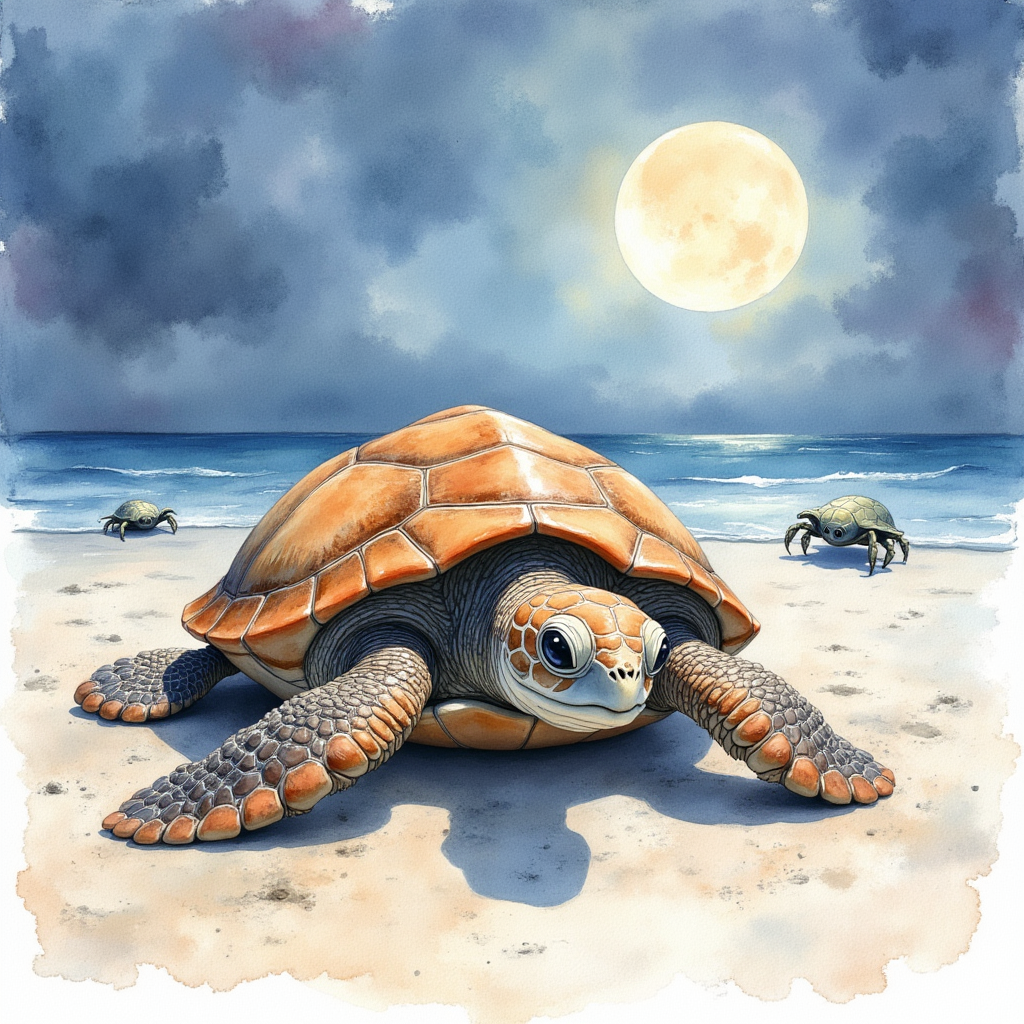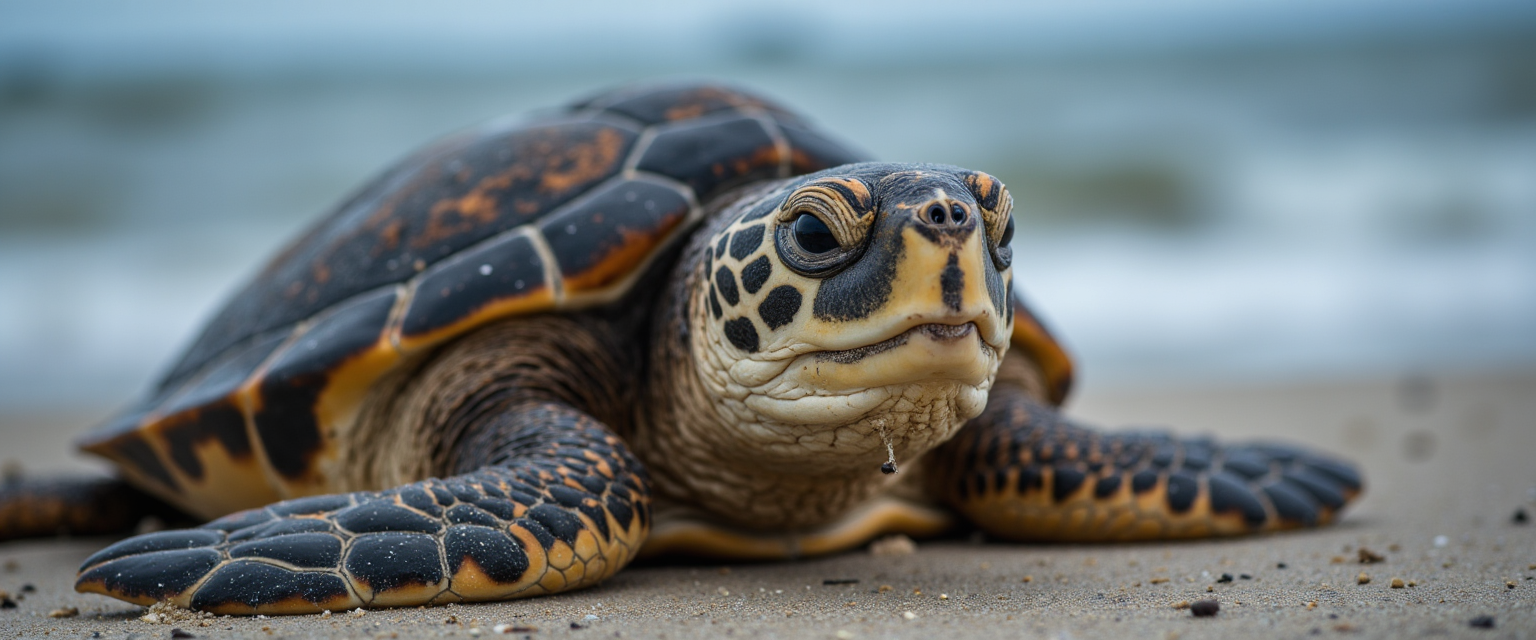"Turtle Me This: Florida’s Giant Beach Bums"
loggerhead sea turtle on Beach at Night
There’s something quietly uncanny about Florida beaches after dark. Gentle waves lap the shore, moonlight skims the water, and if you watch long enough you'll spot something the size of a laundry basket hauling itself up the sand like it owns the place.
That, dear reader, is a loggerhead sea turtle — one of Florida’s most persistent and charismatic beachgoers.
If you picture sea turtles as merely slow reptiles with pretty shells, think again. Loggerheads are long-lived ocean wanderers with personalities as distinctive as their heavy, leathery carapaces. These aren't just animals — they’re living links to an older world wrapped in tough armor.
So let’s dive in — figuratively, unless you’re standing waist-deep in the Atlantic — and explore the surprising, sometimes absurd life of Florida’s loggerhead sea turtles.
The loggerhead, known scientifically as Caretta caretta, is hard to miss. An adult can reach roughly three feet in shell length and weigh several hundred pounds; powerful jaws let it crush crabs and other hard-shelled prey. Their oversized heads give the species its common name, and their presence on Florida beaches is unmistakable.
They’re calm and deliberate — imagine a beach yogi with an ancient attitude and a stubborn streak.
Loggerheads are also remarkably ancient in their lineage: the broader group of marine turtles dates back tens of millions of years, with fossil relatives appearing well over 100 million years ago. While the exact modern species hasn't been unchanged for that entire span, the lineage’s long history helps explain their resilience and specialized adaptations.
Today these veteran travelers are especially visible in Florida during nesting season. Starting in late spring, female loggerheads return — often to the very same stretch of sand where they hatched decades earlier — to dig nests and lay eggs with uncanny natal-site fidelity.
Secrets of Sea Turtles: Loggerheads on Florida’s Beaches
The nesting ritual is deliberate and unhurried. A female loggerhead hauls herself ashore under cover of night, drags her heavy body above the high-tide line, and uses her rear flippers to excavate a deep chamber in the sand. She typically lays around 80–120 eggs per clutch (commonly rounded to ~100), deposits them carefully into the cavity, then covers and camouflages the nest before returning to the sea—leaving the eggs to incubate on their own.
It’s the ultimate drop-and-go parenting: no nest attendance, no feeding, just precise timing and remarkable fidelity to the nesting beach.
A large loggerhead sea turtle emerges from the Atlantic Ocean under the glow of a full moon, crawling onto a Florida beach.
Mating season usually peaks in spring. Courtship and mating occur offshore, where multiple males may pursue one female in what can look like a chaotic scramble—flippers and shells colliding as males compete for access. A single female may be pursued by several males, and mating bouts can last for hours.
After eggs are laid, incubation under the warm Florida sand lasts roughly 50–70 days, depending on temperature. Hatchlings generally emerge at night and instinctively head toward the brightest horizon, which in natural conditions is the moonlight reflecting off the ocean surface.
Modern beachfront lighting disrupts that cue: artificial lights from houses, hotels, and parking areas can disorient hatchlings, causing them to move inland instead of toward the water. Disorientation increases mortality risk from dehydration, vehicle strikes, and predation in yards or streets.
If hatchlings do reach the water, their survival odds remain slim. Predators such as shorebirds, raccoons, crabs, and fish take many young turtles during the crawl and early swim. Estimates commonly cited suggest as few as one in 1,000 hatchlings survive to adulthood, though survival rates vary by region and study.
Those that survive the early peril enter what researchers call the “lost years.” Young loggerheads spend years in pelagic habitats—some evidence points to drifting in areas like the Sargasso Sea—feeding on jellyfish, crustaceans, and other prey while growing and maturing out of sight of beaches and people.
Over the next two to three decades they grow, forage, and migrate widely. Many loggerheads reach sexual maturity in their 20s to 30s, at which point the cycle of long-distance movement and beach return for nesting may begin for females.
What’s remarkable is that loggerhead sea turtles undertake extensive, often transoceanic movements over their lifetime. Individuals tagged in Florida have been tracked traveling thousands of miles, using cues such as the Earth’s magnetic field and ocean currents to navigate areas of the sea that scientists are still working to fully describe.
Outside of nesting periods, loggerheads use a wide range of marine habitats. Depending on population and life stage, they’re encountered along the coasts of Mexico and the Caribbean, in offshore regions such as the Azores and Sargasso Sea,
and occasionally as far north as Nova Scotia. These distribution records reflect the species’ ability to occupy both coastal and pelagic environments across the world.
Loggerheads are long-distance travelers and important members of marine ecosystems, but many populations face significant threats in both coastal and open-ocean phases of their life. Threats — from fisheries bycatch to habitat loss — affect animals at sea and on beaches, making conservation a multi‑habitat challenge.
Loggerhead sea turtles are listed as threatened in many parts of their range. Major human-caused threats include loss of coastal habitat from beachfront development, artificial lighting at night, collisions with boats, entanglement in discarded fishing gear, and the broader effects of climate change.
Beach development reduces available nesting beaches and compresses nest sites. Rising sand temperatures can skew hatchling sex ratios (turtle sex is temperature-dependent during incubation), and plastic pollution and marine debris degrade feeding areas that provide the food young and adult turtles need.
Conservation actions are straightforward and effective when widely adopted. Here’s a concise, beach-friendly checklist you can follow to help loggerheads:
Lights out during nesting and hatching season — turn off or shield beachfront lights, and use turtle-friendly, long-wavelength (red or amber) bulbs where required by local guidelines.
Keep the beach free of trash — remove plastic bags, wrappers, and other debris that can be mistaken for jellyfish or otherwise injure turtles.
Respect nesting turtles and nests — give nesting females space, do not use flash photography, and never dig near marked nests.
Flatten or stow beach furniture, fill in holes, and knock down sandcastles before you leave so hatchlings have a clear path to the water.
If you encounter an injured or stranded turtle, contact local authorities or a licensed rescue organization rather than moving the animal yourself.
Local and national organizations provide guidance, rescue services, and volunteer opportunities. The Loggerhead Marinelife Center in Juno Beach treats and rehabilitates injured turtles and runs public education programs. The Sea Turtle Conservancy conducts research, tracking, and advocacy across the Caribbean and beyond.
For state-specific rules, nesting updates, and reporting procedures, consult Florida Fish and Wildlife resources (search for “Florida Fish and Wildlife Sea Turtle Protection” to find current guidelines). If you want to support on-the-ground work, consider donating, adopting a turtle through reputable programs, or joining local beach cleanups and monitoring efforts.
A close-up of a loggerhead turtle
Still not impressed?
Consider this: loggerhead sea turtles belong to a lineage of marine turtles with deep evolutionary roots—fossil relatives date back tens of millions of years. While the modern species Caretta caretta is not literally unchanged since the age of dinosaurs, their long history across geological time highlights remarkable adaptive success through major environmental shifts.
And they continue to return faithfully to nest on beaches year after year.
Florida may boast alligators and manatees, but the loggerhead turtle captures a particular slice of the state’s character: ancient, stubborn, and unmistakably part of the natural world.
So next time you walk barefoot along the sand and see a distinctive track that looks like someone dragged a trash can, pause.
You may have just crossed paths with a creature older than the pyramids—a quiet, sandy survivor with a carapace that tells a long story of life at sea.
And she didn’t even need a map.
Want to help loggerhead sea turtles? Quick actions you can take right now:
Turn off or shield beachfront lights during nesting/hatching season (check local ordinances for dates).
Report stranded or disoriented hatchlings to local wildlife authorities—search for your county’s sea turtle hotline or contact Florida Fish and Wildlife.
Remove litter and participate in beach cleanups to reduce plastic and marine debris.
When visiting the beach, avoid disturbing marked nests and give nesting females plenty of space.
Resources:
Loggerhead Marinelife Center – Turtle hospital, rescue, education, and conservation programs.
Sea Turtle Conservancy – Research, tracking, advocacy, and turtle adoption programs. Florida Fish and Wildlife Sea Turtle Protection – state guidelines, nesting updates, and reporting procedures.
Ocean Conservancy – Trash Free Seas: resources for reducing marine debris and organizing cleanups.
Earl Lee
"Thanks for reading. Until next time, keep exploring Florida's peculiar charm!"
Florida Unwritten Staff
floridaunwritten.com




